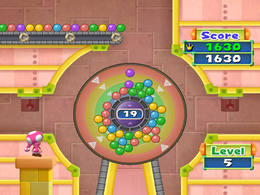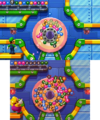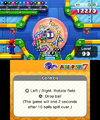Stick and Spin
| Stick and Spin | |||
|---|---|---|---|

| |||
| Appears in | Mario Party 7 Mario Party DS Mario Party: The Top 100 Mario Party Superstars | ||
| Type | Rare minigame (Mario Party 7) Puzzle minigame (Mario Party DS) Special minigame (Mario Party: The Top 100) Sports & Puzzles minigame (Mario Party Superstars) | ||
| Initial record | 0 points (Mario Party 7) 20 points (Mario Party DS, Mario Party: The Top 100, and Mario Party Superstars) | ||
| Music track | A Rare Minigame (Mario Party 7, Mario Party: The Top 100, and Mario Party Superstars) Think It Out (Mario Party DS) | ||
| |||
Stick and Spin is a Rare minigame in Mario Party 7, a Puzzle minigame in Mario Party DS, a Special minigame in Mario Party: The Top 100, and a Sports & Puzzles minigame in Mario Party Superstars. Its name is a pun on either the phrase "thick and thin" or the name of a children's toy manufactured by Playskool called the Sit n' Spin. In Mario Party: The Top 100, this minigame is unlocked after the player obtains 200 Mini Stars in Minigame Island.
Gameplay
The aim of the game is to make matches of five or more balls with the same color, and connected balls are indicated by lines linked between them. To control the circle, the player needs to spin the wheel with ![]() . By pressing
. By pressing ![]() , the ball will immediately drop to the bottom. Only in Mario Party Superstars does this minigame have different patterns for each of the colored marbles. The objective is to clear a set number of balls to advance a level. The number of balls that are needed to be cleared is listed in the middle of the circle. As soon as a ball is going to be cleared, the number is decreased based on that quantity, although in Mario Party Superstars, the number decreases only after the cleared balls disappear completely. In both Mario Party 7 and Mario Party DS, the scoring is based on how many matches while the balls involved in scoring are present, where the number of points gained increases after every match made. Whereas, in both Mario Party: The Top 100 and Mario Party Superstars, the scoring is based on the number of balls eliminated, where every ball eliminated grants points as long as it contributes to the objective.
, the ball will immediately drop to the bottom. Only in Mario Party Superstars does this minigame have different patterns for each of the colored marbles. The objective is to clear a set number of balls to advance a level. The number of balls that are needed to be cleared is listed in the middle of the circle. As soon as a ball is going to be cleared, the number is decreased based on that quantity, although in Mario Party Superstars, the number decreases only after the cleared balls disappear completely. In both Mario Party 7 and Mario Party DS, the scoring is based on how many matches while the balls involved in scoring are present, where the number of points gained increases after every match made. Whereas, in both Mario Party: The Top 100 and Mario Party Superstars, the scoring is based on the number of balls eliminated, where every ball eliminated grants points as long as it contributes to the objective.
After every five levels, starting with Level 6, the board resets and a brand-new board is presented, with a new gameplay element added, starting at Level 11. Mario Party 7 is also the only version where the balls on the conveyor belt can change their state when leveling up within a set of levels, so for example, within Levels 96 to 100, the ball sizes get larger as soon as a level up occurs. On certain sets of levels, the drop speed of the balls might increase, making it so that they drop faster than before. The speed change in Mario Party 7 and Mario Party DS can be faster or slower between certain sets of levels, while in Mario Party: The Top 100 and Mario Party Superstars there are only speed increases after certain sets of levels. Another thing that may happen between sets of levels is that the size of the circle may change to become slightly smaller or larger, and the most drastic change happens at Levels 56 to 60, which shrinks the circle to fit only one layer of normal-sized balls, where it happens only for this set of levels.
The game ends when 10 balls spill over and two seconds pass before the player can reduce the number of balls sticking out of the circle. If a ball is spilled over, it is indicated by dotted lines circling that ball. Balls that are cleared do not count as being spilled over. In Mario Party 7 and Mario Party Superstars, a checkpoint will be reached every five levels, starting at Level 6. If this happens, the player may continue from the last checkpoint, but it will cost them around half of their score provided that they have reached a new checkpoint. If they did not progress past the same checkpoint, the score deduction becomes greater for each successive Game Over until it starts from zero. In Mario Party DS, the player may continue from the last level they have gotten a Game Over on, but the score will reset to zero. In Mario Party: The Top 100, the player cannot continue from one of the later levels unlike in the other versions, so they can start from only Level 1 should the player get a Game Over. The game also ends in Mario Party 7 after the player clears Level 100, although this minigame is endless in every other version, where clearing Level 99 will reset that particular level.
There are several types of balls introduced throughout the levels:
- Colored balls: Five or more like-colored balls will be eliminated when they are linked, indicated by lines that join them when they touch each other. There are six different colors of balls in Mario Party 7 and Mario Party DS: red, light blue, yellow, green, purple, and dark blue. In Mario Party: The Top 100 and Mario Party Superstars, there are only five colors: red, light blue, yellow, green, and purple. Mario Party 7 is also the only version where certain levels do not have a fixed set of colors based on the number of colors.
- Different-sized balls: The balls can come in different sizes compared to the standard size. Other than being of a different size, the balls work the same way as their normal-sized counterparts.
- Bubbles: These are transparent balls that, when a ball is dropped on them, will be popped. They will not pop if a ball dropped on them as a result of another ball tumbling on them, nor will they pop when a match is made adjacent to them. In Mario Party Superstars, popping bubbles will contribute to the number of balls needed to be eliminated.
- Gray balls: These balls will require a match made next to them to eliminate, and will contribute to the total number of balls needed to be eliminated, except in Mario Party DS.
- Black and white balls: These are similar to colored balls in that five or more like-colored balls will be eliminated when they are linked. Unlike colored balls, when a ball is dropped on them, a black ball will be changed to a white ball, and vice-versa. They will not change color if a ball dropped on them as a result of another ball tumbling on them.
- Numbered balls: Balls with numbers on them indicate the number of times a certain ball needs to be cleared before it completely disappears. Upon the conditions for eliminating the ball being met, if the number is more than one, it is decreased by one; if the number is one, the number will disappear before the ball is eliminated completely. The number can be reduced further if an extra ball is added during a match before the linked balls disappear, including when a gray numbered ball is next to that match. In the case of numbered balls needing to be linked to be eliminated, the match will keep getting made as long as five or more balls are linked. However, in Mario Party Superstars, even if there are five or more like-colored numbered balls linked together after all the numbers are reduced by one but are not yet eliminated, another like-colored ball must be added to eliminate them again.
In Mario Party 7, the staff record for this minigame is 20,190 points in the American version, 49,320 points in the Japanese version, and 49,620 points in the European/Australian version. In Mario Party DS, it is 11,130 points in all versions.
Level summary
Every set of levels has different elements in play, and each version of this minigame contains differences. They are as follows: (All = all versions; 7 = Mario Party 7; DS = Mario Party DS; TT100 = Mario Party: The Top 100; SS = Mario Party Superstars)
| Level set | Starting layout | Colors | Other features | Balls required to be cleared | |
|---|---|---|---|---|---|
| 7 and DS | TT100 and SS | ||||
| 1–5 |
|
|
|
25 (all) |
15/15/15/20/20 |
| 6–10 |
|
|
|
7: 25/22/35/25/20 |
15/15/15/20/20 |
| 11–15 |
|
|
|
30/25/20/25/20 |
20 (all) |
| 16–20 |
|
|
|
30/25/30/25/20 |
20 (all) |
| 21–25 |
|
|
|
30/25/30/25/30 |
20/20/30/20/30 |
| 26–30 |
|
|
|
30 (all) |
20 (all) |
| 31–35 |
|
|
|
30/25/30/25/30 |
20/20/30/20/30 |
| 36–40 |
|
|
|
30 (all) |
25 (all) |
| 41–45 |
|
|
|
30/25/30/25/30 |
25/25/25/25/30 |
| 46–50 |
|
|
|
32 (all) |
25 (all) |
| 51–55 |
|
|
|
25 (all) | |
| 56–60 |
|
|
|
27 (all) |
25 (all) |
| 61–65 |
|
|
|
25 (all) | |
| 66–70 |
|
|
|
25 (all) | |
| 71–75 |
|
|
|
40/40/30/30/30 |
25/25/25/30/30 |
| 76–80 |
|
|
|
30 (all) | |
| 81–85 |
|
|
|
30/25/25/25/25 |
25 (all) |
| 86–90 |
|
|
|
32 (all) |
30 (all) |
| 91–95 |
|
|
|
30 (all) | |
| 96–100 |
|
|
|
7: 32/32/32/35/35 |
30/30/30/35 |
Multiplayer
Stick and Spin can also be played with two players. A few gameplay elements from the single-player game are present as well. The two-player game is played as a survival game, as whoever has 10 balls sticking out of the circle first will lose. As the game goes on, the balls will drop faster and faster. Numbered balls will also be present, and they will fall on both players' screens. However, if one player makes big combos, more numbered balls will be sent to their opponent.
Controls
Mario Party 7
 – Spin the stage
– Spin the stage – Drop balls
– Drop balls
Mario Party DS
– Spin wheel
 – Drop piece
– Drop piece
Mario Party: The Top 100
Left / Right: Rotate field
: Drop ball
- (The game will end 2 seconds after 10 balls spill over.)
Mario Party Superstars
(Left and Right) – Rotate Field
- – Drop Ball
In-game text
Mario Party 7
One Player
- Rules – "Connect 5 or more balls of the same color to eliminate them. When you clear a set number, you'll go to the next stage."
- Advice 1 – "The number in the center shows how many balls are remaining."
- Advice 2 – "If a stack gets too high, balls will flow over the top of the circle. If 10 balls overflow, you lose--so watch for the blue warning lights."
Two Players
- Rules — "Connect 5 or more balls of the same color to eliminate them. The first person to have 10 balls sticking out of the circle loses."
- Advice — "Use the special Vexing Balls to give your opponent no end of trouble!"
Mario Party DS
One Player
- Rules – "Rotate the cylinder to clear balls by connecting five or more of the same color. You have to clear a certain number of balls to clear a level."
- Tips – "If 10 or more balls stick out past the outer blue ring, your game will end after two seconds, so be careful!"
Two Players
- Rules – "Rotate the cylinder to clear balls by connecting five or more of the same color. You'll lose if 10 or more balls stick out past the outer blue ring."
- Tips – "If you clear a lot of balls, you can cause trouble for your opponent!"
Mario Party: The Top 100
- Description – "Rotate the field and connect 5 or more same-colored balls to clear them!"
- On-screen (Vs. mode) – "Connect 5 or more same-colored balls to clear them!"
- On-screen (Endless mode) – "Connect 5 or more same-colored balls and clear the number shown!"
Mario Party Superstars
- "Connect five or more balls to remove them! Numbered balls go to your rival if removed. If 10 balls cross the edge, it's game over."
Gallery
Names in other languages
| Language | Name | Meaning | Notes |
|---|---|---|---|
| Japanese | かいてんパズル[?] Kaiten Pazuru |
Spin Puzzle | |
| Dutch | Keren en kleven[?] | Spin and stick | |
| French (NOA) | Attraction nucléaire[?] | Nuclear Attraction | |
| French (NOE) | Magnepuzzle[?] | Portmanteau of magnet and puzzle | |
| German | Kullerkoller[?] | Roly-poly | |
| Italian | Pallapuzzle[?] | Ball Puzzle | |
| Korean | 회전 퍼즐(DS) Hoejeon Peojeul 회전 구슬 퍼즐 (Superstars) Hoejeon Guseul Peojeul[?] |
Spin Puzzle Spin Orb Puzzle |
|
| Portuguese | Roda de Grude[?] | "Sticky Wheel", pun on bola de gude (marble) | |
| Russian | Шародром[?] Sharodrom |
? | |
| Spanish | Atracción nuclear[?] | Nuclear Attraction |
Trivia
- This minigame is the only one other than Block Star not originally introduced in the first Mario Party to appear four times in the series.





